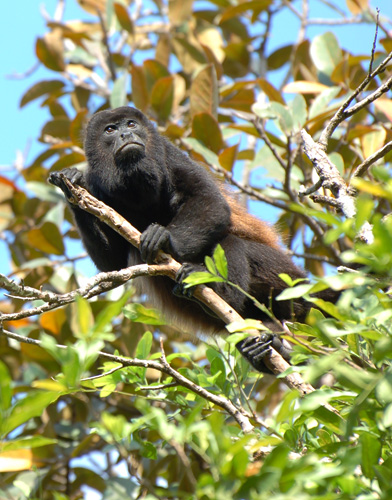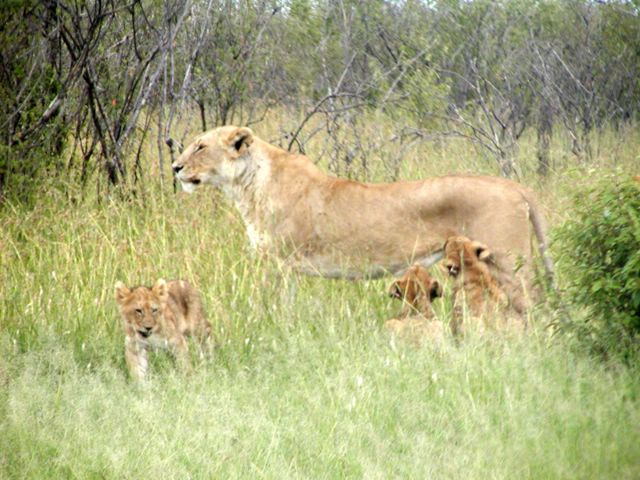|
Folivory
In zoology, a folivore is a herbivore that specializes in eating leaves. Mature leaves contain a high proportion of hard-to-digest cellulose, less energy than other types of foods, and often toxic compounds.Jones, S., Martin, R., & Pilbeam, D. (1994) ''The Cambridge Encyclopedia of Human Evolution''. Cambridge: Cambridge University Press For this reason, folivorous animals tend to have long digestive tracts and slow metabolisms. Many enlist the help of symbiotic bacteria to release the nutrients in their diet. Additionally, as has been observed in folivorous primates, they exhibit a strong preference for immature leaves, which tend to be easier to masticate, tend to be higher in energy and protein, and lower in fibre and poisons than more mature fibrous leaves. Evolution Herbivory has evolved several times among different groups of animals. The first vertebrates were small fish that consumed protists and invertebrates. After these fish, the next group of vertebrates to evolve ... [...More Info...] [...Related Items...] OR: [Wikipedia] [Google] [Baidu] |
Lemur
Lemurs ( ) (from Latin ''lemures'' – ghosts or spirits) are Strepsirrhini, wet-nosed primates of the Superfamily (biology), superfamily Lemuroidea (), divided into 8 Family (biology), families and consisting of 15 genera and around 100 existing species. They are endemic to the island of Madagascar. Most existing lemurs are small, have a pointed snout, large eyes, and a long tail. They arboreal, chiefly live in trees and nocturnal, are active at night. Lemurs share resemblance with other primates, but evolved independently from monkeys and apes. Due to Madagascar's highly seasonal climate, Evolution of lemurs, lemur evolution has produced a level of species diversity rivaling that of any other primate group. Until shortly after humans arrived on the island around 2,000 years ago, there were lemurs as large as a male gorilla. Most species have been discovered or promoted to full species status since the 1990s; however, lemur Taxonomy (biology), taxonomic classification is ... [...More Info...] [...Related Items...] OR: [Wikipedia] [Google] [Baidu] |
Elephant Mother
Elephants are the Largest and heaviest animals, largest existing land animals. Three living species are currently recognised: the African bush elephant, the African forest elephant, and the Asian elephant. They are the only surviving members of the Family (biology), family Elephantidae and the Order (biology), order Proboscidea. The order was formerly much more diverse during the Pleistocene, but most species became extinct during the Late Pleistocene epoch. Distinctive features of elephants include a long proboscis called a trunk, tusks, large ear flaps, pillar-like legs, and tough but sensitive skin. The trunk is used for breathing, bringing food and water to the mouth, and grasping objects. Tusks, which are derived from the incisor teeth, serve both as weapons and as tools for moving objects and digging. The large ear flaps assist in maintaining a constant body temperature as well as in communication. African elephants have larger ears and concave backs, whereas Asian elepha ... [...More Info...] [...Related Items...] OR: [Wikipedia] [Google] [Baidu] |
Arboreal
Arboreal locomotion is the Animal locomotion, locomotion of animals in trees. In habitats in which trees are present, animals have evolved to move in them. Some animals may scale trees only occasionally, but others are exclusively arboreal. The habitats pose numerous mechanical challenges to animals moving through them and lead to a variety of anatomical, behavioral and ecological consequences as well as variations throughout different species.Cartmill, M. (1985). Climbing. In ''Functional Vertebrate Morphology'', eds. M. Hildebrand D. M. Bramble K. F. Liem and D. B. Wake, pp. 73–88. Cambridge: Belknap Press. Furthermore, many of these same principles may be applied to climbing without trees, such as on rock piles or mountains. Some animals are exclusively arboreal in habitat, such as the tree snail. Biomechanics Arboreal habitats pose numerous mechanical challenges to animals moving in them, which have been solved in diverse ways. These challenges include moving on n ... [...More Info...] [...Related Items...] OR: [Wikipedia] [Google] [Baidu] |
Okapi2
The okapi (; ''Okapia johnstoni''), also known as the forest giraffe, Congolese giraffe, or zebra giraffe, is an artiodactyl mammal that is endemic to the northeast Democratic Republic of the Congo in central Africa. It is the only species in the genus ''Okapia''. Although the okapi has striped markings reminiscent of zebras, it is most closely related to the giraffe. The okapi and the giraffe are the only living members of the family Giraffidae. The okapi stands about tall at the shoulder and has a typical body length around . Its weight ranges from . It has a long neck, and large, flexible ears. Its coat is a chocolate to reddish brown, much in contrast with the white horizontal stripes and rings on the legs, and white ankles. Male okapis have short, distinct horn-like protuberances on their heads called ossicones, less than in length. Females possess hair whorls, and ossicones are absent. Okapis are primarily diurnal, but may be active for a few hours in darkness. They ... [...More Info...] [...Related Items...] OR: [Wikipedia] [Google] [Baidu] |
Howler Monkey
Howler monkeys (genus ''Alouatta'', monotypic in subfamily Alouattinae) are the most widespread primate genus in the Neotropics and are among the largest of the platyrrhines along with the muriquis (''Brachyteles''), the spider monkeys (''Ateles'') and woolly monkeys (''Lagotrix''). These monkeys are native to South and Central American forests. They are famous for their loud howls, which can travel more than a mile through dense rain forest. Fifteen species are recognized. Previously classified in the family Cebidae, they are now placed in the family Atelidae. They are primarily folivores but also significant frugivores, acting as seed dispersal agents through their digestive system and their locomotion. Threats include human predation, habitat destruction, and capture for pets or zoo animals. Classification * ''A. palliata'' group ** Coiba Island howler, ''Alouatta coibensis'' *** ''Alouatta coibensis coibensis'' *** Azuero howler, ''Alouatta coibensis trabeata'' ** Mantled h ... [...More Info...] [...Related Items...] OR: [Wikipedia] [Google] [Baidu] |
New World
The term ''New World'' is often used to mean the majority of Earth's Western Hemisphere, specifically the Americas."America." ''The Oxford Companion to the English Language'' (). McArthur, Tom, ed., 1992. New York: Oxford University Press, p. 33: "[16c: from the feminine of ''Americus'', the Latinized first name of the explorer Amerigo Vespucci (1454–1512). The name ''America'' first appeared on a map in 1507 by the German cartographer Martin Waldseemüller, referring to the area now called Brazil]. Since the 16c, a name of the western hemisphere, often in the plural ''Americas'' and more or less synonymous with ''the New World''. Since the 18c, a name of the United States of America. The second sense is now primary in English: ... However, the term is open to uncertainties: ..." The term gained prominence in the early 16th century, during Europe's Age of Discovery, shortly after the Italian explorer Amerigo Vespucci concluded that America (now often called ''the Am ... [...More Info...] [...Related Items...] OR: [Wikipedia] [Google] [Baidu] |
Infanticide (zoology)
In animals, infanticide involves the intentional killing of young offspring by a mature animal of the same species. Animal infanticide is studied in zoology, specifically in the field of ethology. Ovicide is the analogous destruction of eggs. The practice has been observed in many species throughout the animal kingdom, especially primates ( primate infanticide) but including microscopic rotifers, insects, fish, amphibians, birds and mammals. Infanticide can be practiced by both males and females. Infanticide caused by sexual conflict has the general theme of the killer (often male) becoming the new sexual partner of the victim's parent, which would otherwise be unavailable. This represents a gain in fitness by the killer, and a loss in fitness by the parents of the offspring killed. This is a type of evolutionary struggle between the two sexes, in which the victim sex may have counter-adaptations that reduce the success of this practice. It may also occur for other reasons, suc ... [...More Info...] [...Related Items...] OR: [Wikipedia] [Google] [Baidu] |
Primate
Primates are a diverse order of mammals. They are divided into the strepsirrhines, which include the lemurs, galagos, and lorisids, and the haplorhines, which include the tarsiers and the simians (monkeys and apes, the latter including humans). Primates arose 85–55 million years ago first from small terrestrial mammals, which adapted to living in the trees of tropical forests: many primate characteristics represent adaptations to life in this challenging environment, including large brains, visual acuity, color vision, a shoulder girdle allowing a large degree of movement in the shoulder joint, and dextrous hands. Primates range in size from Madame Berthe's mouse lemur, which weighs , to the eastern gorilla, weighing over . There are 376–524 species of living primates, depending on which classification is used. New primate species continue to be discovered: over 25 species were described in the 2000s, 36 in the 2010s, and three in the 2020s. Primates have large bra ... [...More Info...] [...Related Items...] OR: [Wikipedia] [Google] [Baidu] |
Group Size Measures
Many animals, including humans, tend to live in groups, herds, flocks, bands, packs, shoals, or colonies (hereafter: groups) of conspecific individuals. The size of these groups, as expressed by the number of people/etc in a group such as eight groups of nine people in each one, is an important aspect of their social environment. Group size tend to be highly variable even within the same species, thus we often need statistical measures to quantify group size and statistical tests to compare these measures between two or more samples. Group size measures are notoriously hard to handle statistically since groups sizes typically follow an aggregated (right-skewed) distribution: most groups are small, few are large, and a very few are very large. Statistical measures of group size roughly fall into two categories. Outsiders' view of group size * Group size is the number of individuals within a group; * Mean group size, the arithmetic mean of group sizes averaged over groups; * Co ... [...More Info...] [...Related Items...] OR: [Wikipedia] [Google] [Baidu] |
Ecological Theory
Theoretical ecology is the scientific discipline devoted to the study of ecosystem, ecological systems using theoretical methods such as simple conceptual models, mathematical models, computer simulation, computational simulations, and advanced data analysis. Effective models improve understanding of the natural world by revealing how the dynamics of species populations are often based on fundamental biological conditions and processes. Further, the field aims to unify a diverse range of empirical observations by assuming that common, mechanistic processes generate observable phenomena across species and ecological environments. Based on biologically realistic assumptions, theoretical ecologists are able to uncover novel, non-intuitive insights about natural processes. Theoretical results are often verified by empirical and observational studies, revealing the power of theoretical methods in both predicting and understanding the noisy, diverse biological world. The field is broad a ... [...More Info...] [...Related Items...] OR: [Wikipedia] [Google] [Baidu] |
Hominoid
Apes (collectively Hominoidea ) are a clade of Old World simians native to sub-Saharan Africa and Southeast Asia (though they were more widespread in Africa, most of Asia, and as well as Europe in prehistory), which together with its sister group Cercopithecidae form the catarrhine clade, cladistically making them monkeys (though this is the subject of much debate). Apes do not have tails due to a mutation of the T-box transcription factor T, TBXT gene. In traditional and non-scientific use, the term "ape" can include tailless primates taxonomically considered Cercopithecidae (such as the Barbary ape and Celebes crested macaque, black ape), and is thus not equivalent to the scientific taxon Hominoidea. There are two extant branches of the superfamily Hominoidea: the gibbons, or lesser apes; and the hominids, or great apes. * The family Hylobatidae, the lesser apes, include four genera and a total of 20 species of gibbon, including the lar gibbon and the siamang, all native to A ... [...More Info...] [...Related Items...] OR: [Wikipedia] [Google] [Baidu] |


_colourised.png)

.jpg)


.jpg)
.jpg)